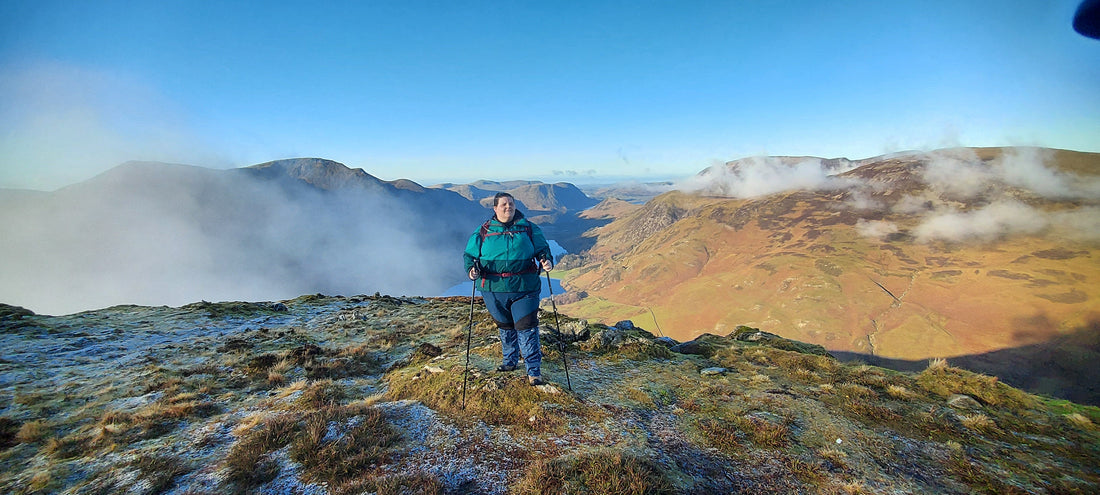
Embracing Winter Hiking: A Guide to Plus Size Outdoor Adventures
Share
Whether it’s the crisp, cold air, majestic landscapes, or calm countryside and the absence of crowds, winter hiking an unparalleled experience. However, for plus-size individuals, the joy of hiking in winter can come with its own set of challenges.
In this blog post, we’ll explore the pleasures of winter hiking in the UK while acknowledging the obstacles faced by plus-size hikers and how to overcome them. We’ll look at how investing in well-fitting outdoor gear to suit larger body sizes can enhance the overall experience, and turn something that may have felt inaccessible or uncomfortable, into an enjoyable and rewarding adventure.
Reasons to go hiking in winter
1. Serenity amidst wintery landscapes: Winter transforms the British countryside into a magical wonderland. Snow-covered hills, frost-kissed trees, and the peaceful ambiance create an inviting setting for anyone who wants to get outdoors and go walking or hiking in winter.
2. Avoid the crowds: Winter provides a reprieve from the bustling crowds that often accompany summer hikes. The solitude allows for a more intimate connection with nature and a chance to appreciate the beauty of the landscape without distractions. You’re more likely to be able to find a car parking spot in busy places too!
3. Unique wildlife encounters: Winter hiking unveils a different side of nature, showcasing resilient wildlife adapted to colder conditions. Spotting deer, foxes, and a host of winter resident and migratory birds against the wintry sky can be a delightful experience.
Winter hiking tips for plus size people
While the joys of winter hiking are undeniable, plus-size people and those with larger bodies may find it more challenging due to the difficulties in finding appropriate clothing and gear.Here are our tips to a more enjoyable experience:
1. Clothing that Fits: Investing in plus-size outdoor clothing is essential for regulating body temperature. Layering is key, and having breathable, moisture-wicking materials will keep you warm without causing overheating.
2. Use layers to keep warm: Having one thick outer layer can often result in overheating when there is any additional effort required. Having several thinner layers, though it might seem counterintuitive, is actually better when you’re hiking in colder weather.
Start with a thin, long-sleeved base layer, either in natural materials like Merino wool, or a synthetic top that wicks-away sweat. Follow this with a mid-layer, commonly a fleece-type material. Grid-style fleeces are excellent at trapping air to keep you warm but also allowing you to vent quickly if you get too hot.
Finally, a warm and/or waterproof layer, depending on the weather conditions. Warm puffy jackets are a great choice in colder weather but avoid down if you’re going anywhere wet. Synthetic-fill jackets retain warmth even while wet, unlike down.
In wet weather a good-quality waterproof jacket is essential, and it can also act as a wind barrier even in dry conditions. Choose one with large vents to quickly and easily regulate your temperature.
3. Supportive Footwear: Choosing the right pair of boots is important. Ensure they provide adequate ankle support, are waterproof, and have enough insulation to keep your feet warm in cold conditions.
When trying boots on, wear the socks you’ll be using for hiking and remember that in winter you’ll often be wearing thicker socks than you will in the summer.
Unless you’re planning to tackle high mountains with rocky scrambles or icy climbs, you aren’t going to need a rigid leather boot or crampon-compatibility, so go for something waterproof but comfortable, with deep lugs on the sole for good grip.
In icy weather consider getting some ice grippers – small spikes that go over your boots – suitable for low-level walking when you need extra grip.
4. Plus Size Backpacks: A backpack is an essential item for any hiker, but plus size people often find regular-sized backpacks quite uncomfortable or ill-fitting with hip belts that are too small, and shoulder straps that rub under the arms.
Plus-size specific backpacks provide all the space to carry your extra layers, food, first aid kit and water for a hike, and are designed to better-fit plus size bodies, with re-designed and larger hip belts and shoulder harness.
Having a well-fitting pack ensures weight is distributed evenly, reducing strain on the back and shoulders.
5. Use hiking poles: While they may have once been the preserve of older Ramblers, hiking poles are now a mainstay of hiking equipment, used by everyone from long-distance hikers and trail runners, to every day walkers.
Choose a pair that are sufficiently adjustable that your elbow is at a right angle when holding the grips, and always, always use two poles! This ensures you distribute your bodyweight evenly, preventing strains and potential injury.
The key is not to think of poles as just a stability aid (though they definitely do provide that) but as a propulsion device, powering you forwards and upwards, and helping you to walk further for the same effort, protecting your joints, and giving you an all-body workout.
They are also good on downhills for stability, to help take the strain from your knees, and also to test the depth of puddles and bog before you put your foot down!
6. Build up your distance and difficulty: While it may be tempting to set off on an epic adventure, unless you’ve built up to the distance and difficulty level, you risk having to turn around, or worse.
Injuries can easily happen at the best of times, but over-stretching yourself can result in having to call for help if you get into trouble.
Build up your fitness slowly, over days and weeks, gradually increasing the distance or speed, or difficulty level.
Practice your navigation skills by trying new routes and getting to understand how contours on maps relate to uphills and downhills, and how easy or hard you find them.

Image: The view from here! Claire looks down into the valley on a winter hike.
What to pack for a winter hike in the UK
1. Clothing layers:
- Base layer (moisture-wicking) such as this Merino long-sleeved top, or this hooded layer.
- Mid-layer such as this grid fleece.
- Insulating layer such as the synthetic-fill Superstrand hoodie or jacket.
- Waterproof and windproof outer layer such as this Gore-tex jacket.
2. Insulated Gloves and Hat:
- Protect extremities from the cold with a warm hat, and a pair of gloves.
3. Waterproof Boots:
- Ensure they provide good traction on slippery surfaces.
4. Plus Size Backpack:
- Choose one with adjustable straps and hip belt for optimal comfort. Some have an adjustable back height for even more adjustability.
- Check out the Osprey range of extended fit packs and the Gregory range of plus size packs for day hikes and wild camping trips.
5. Water and Hydration System:
- Stay hydrated with an ample supply of water.
- Consider carrying either a reusable water bottle or a hydration bladder, taking into account personal preferences and ease of access during the hike.
6. Emergency Blanket or Bivvy Bag:
- Compact and lightweight, an emergency foil blanket provides an extra layer of warmth in case of unexpected stops or emergencies.
- An emergency bivvy bag or shelter can accommodate more than one person, so is ideal if you’re hiking in a small group.
7. Headtorch:
- Days are shorter in winter, and having a reliable light source is essential for safety, especially if your hike extends into the evening. Don’t rely on your phone, and always pack an additional hand-held torch or headtorch.
8. Hiking Poles:
- Improve your stability, get an all-round workout, and reduce strain on knees, especially on uneven or snowy terrain.
9. Food and Snacks:
- Pack energy-boosting snacks like trail mix, granola bars, and dried fruits to maintain stamina.
- Carry a hearty lunch to keep energy levels sustained throughout the hike. Soup or sandwiches and a chocolate bar or some sweets will help keep you fuelled.
10. Mobile Phone and External Battery Pack:
- Keep your smartphone fully charged and use it for navigation and emergencies.
- Cold temperatures can deplete battery life more quickly, so having an external battery pack ensures you stay connected throughout the hike.
11. First Aid Kit and Personal Hygiene:
- Include essentials such as a selection of plasters, a pair of scissors, sanitary products, pain relief, and any necessary personal medications.
- Tissues and a plastic bag, or a Kula Cloth pee cloth for wild wees. Leave no trace, and ensure you take any waste home with you.
12. Navigation Tools:
- Map and compass, but ensure you know how to read them! If you need help understanding navigation, consider joining a plus size hill skills course run by Every Body Outdoors.
- Consider using a navigation app with downloadable routes for you to follow.
Remember to tailor your packing list based on the specific route, weather conditions, and your personal needs. Winter hiking can be immensely rewarding, and with the right gear, you'll be well-prepared to embrace the beauty of the season while staying safe and comfortable on the trails.
What to consider when choosing a hiking route in winter
Embarking on a winter hike requires careful consideration. Selecting the right trail ensures an enjoyable experience while taking into account individual abilities, fitness levels, and potential obstacles. Here's a guide to help you choose the perfect hiking route:
1. Assess Your Fitness Level:
Be honest about your fitness level and choose a trail that aligns with your abilities. Consider shorter, less strenuous routes if you're a beginner or gradually progress to longer trails as your fitness improves.
2. Length of Hike:
Determine how long you want to spend on the trail. For beginner plus-size hikers, starting with shorter hikes allows you to gauge your comfort level and build confidence before tackling more extended routes.
Once you’re confident in your abilities you can choose longer or more demanding routes.
3. Time of Day:
Plan your hike with consideration for sunrise and sunset times. This is crucial for ensuring you have enough daylight to complete the hike safely, especially during the winter when days are shorter. Remember to pack a torch just in case!
4. Potential Obstacles:
Check the trail for potential obstacles such as stiles, narrow gaps, or gates. Some trails may have these features that can be challenging for plus-size hikers.
Be aware that in some areas of the UK stone stiles and gaps can be very narrow, and some clambering may be required to get through or over them. Researching in advance allows you to choose routes with fewer barriers.
5. Websites for Short Walks:
There are several websites that curate short walks in the UK, ideal for plus-size hikers looking for manageable trails. Websites like Walking in England and Walking Britain provide detailed information on walks, including distance, difficulty, and points of interest.
These websites offer route descriptions, difficulty ratings, and often include user reviews, making it easier to choose a trail that matches your preferences and abilities.
Remember, the goal is to enjoy the experience, so don't hesitate to start with shorter, more accessible trails and gradually progress as you become more comfortable and confident in your abilities.
Winter hiking in the UK offers a unique and enchanting experience for outdoor enthusiasts. For plus-size individuals, the journey becomes more enjoyable with the right gear. Investing in plus-size outdoor clothing, supportive footwear, and backpacks tailored to your needs ensures a comfortable and fulfilling winter hiking adventure. Embrace the beauty of the season, conquer the challenges, and discover the wonders of the British countryside in all its winter glory.
Happy adventuring!
